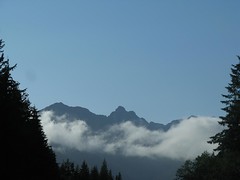Travelling Northern Vancouver Island
The “new road” from Nanaimo to Campbell River takes you high above the ocean, across the tops of the lowlands where the Vancouver Island range mountains slope down to the Strait of Georgia. It’s a long fast stretch of double highway, posted at 110 km/h and taking only an hour and a half, which is a full 30 minutes shorter than the more scenic, but interminably slow Ocean Route.
What you gain in speed though, you lose in character, and other than a few stunning lookouts, the scenery is dominated by recovering clearcuts on the mountains all around. You miss towns completely until you descend into Campbell River. The only crossings north of Parksville are mainline logging roads, with the exception of the road up the Comox Valley.
Off the road however, there are a few places to stop and get some good rest. Whenever I do this trip I always stop in at the Java Shack in Campbell River, which has some of the best espresso on Vancouver Island, and fantastic homemade soups and baking. It’s right down by the ferry dock, so is a great place to stop if you’ve missed the Quadra Island ferry.
Today though I’m pausing here on the way north, into high mountaon logging country, up highway 19 to Port MacNeil. North of Campbell River the road cuts inland through incredibly steep terrain and seeks out the Nimpkish Valley, giving equal access to both sides of the mountains that form the spine of this Island. Up here the economy is strictly about access – access to timber mostly, so the main highway splits the difference between both sides of the Island and the clear cuts come right down to the road. In Sayward once I was almost denied service at a gas station because I tried to pay with my VanCity Enviro Card. People are serious about logging here, and the great unspoken terror of fish farming, an industry that is driving a wedge between people and communities. The Broughton Archipelago, a maze of islands and treacherous channels, is the home to two dozen fish farms and a formerly thriving wild fishery. The wild fish fleets are down significantly – it’s hard to even find wild fish on the menu in Campbell River except at the excellent fish and chips stand in the Discovery Marina – and the resulting hit to traditional diets and ways of life in local First Nations is devastating.
I’ve driven this road dozens of times, awed by the scenery and the impact that humans can have on such a vast territory (see Google maps for evidence of the logging activity, none of which is hidden from view north of Campbell River – in the southern part of the Island, a nod to tourism means that clear cuts are carefully contained behind view corridors that give the impression of pristine forests). Not too many tourists wander up here, and I guess people kind of like it that way. A few make the trek for the world class salmon fishing and the whale watching tours out of Telegraph Cove and a few others get up to Port Hardy and board the ferry for the inside passage to Bella Bella, Bella Coola and Prince Rupert. But by and large this land belongs to the people that live here, Aboriginal and non-Aboriginal, and that’s why I’m here – to run a gathering tomorrow in which these folks will talk to one another about what’s possible together.
Should be interesting.


